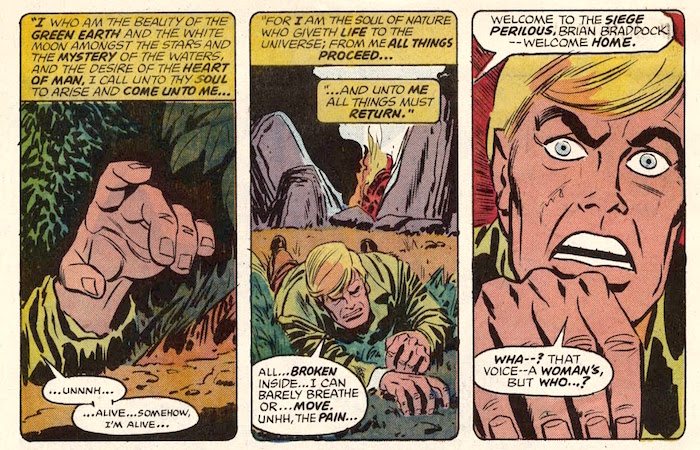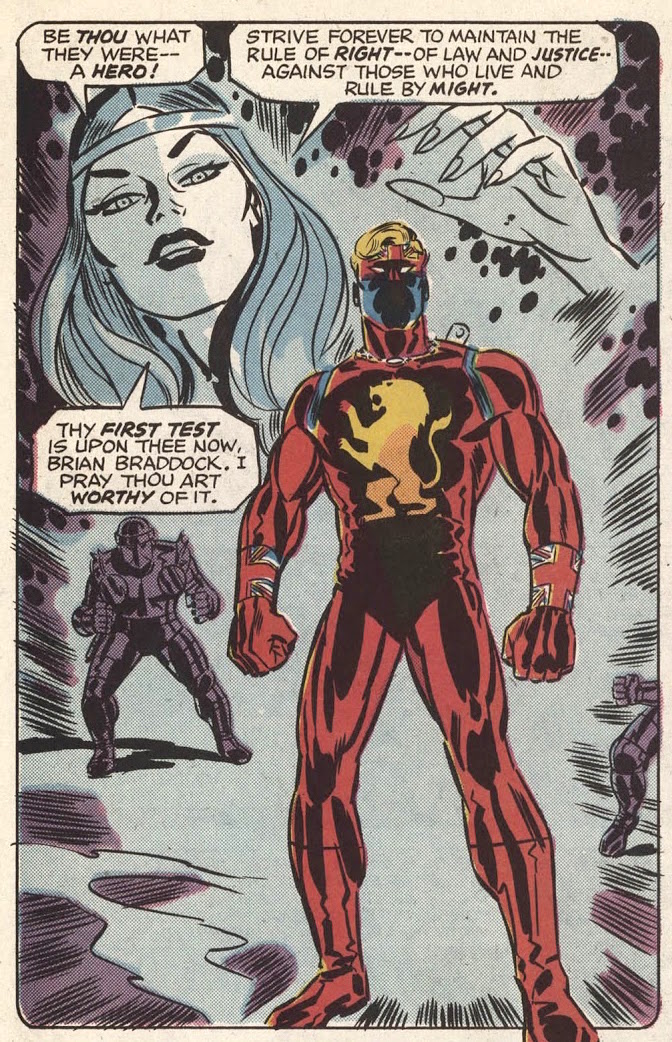In the beginning, there was Claremont.
Chris Claremont was born in London, and that either means something to him or means enough to other people that he talks about it as if it means something about him. In his introduction to the trade collection Captain Britain: Birth of a Hero, Claremont talks about the creation and first ten installments of Captain Britain as a project purposefully handled by American Marvel’s “most British” creative options: himself, with all the resident memories of babyhood underneath the impressions of holiday visits, and Herb Trimpe, who lived in Cornwall for a year. For Captain Britain, the conceptual ur-hero of a united nation, was that enough?
Yes. But—it’s not really fair to say it started there. In the beginning, there was Marvel UK.
Marvel UK, in the olden days (the 1970s), was an office founded by Marvel proper to reprint old American material, after all the British publishers lost interest in doing exactly that. It put out anthology magazines full of black and white US successes, weekly, and eventually monthly. Some kids, teens or adults bought imports from specialty shops, but the average individual went to the newsagent and saw MIGHTY WORLD OF MARVEL or THE SUPER-HEROES, etc. In ‘76, while the office was being run by Neil Tennant (no, not another Neil Tennant, the Pet Shop Boy), Marvel UK debuted its first original material. Rather than waste precious canon from some already-established superhero on a wee small market the British people were given our own, exclusive fellow: an American-style Captain. It’s probably not would would have happened if the effort had been home-grown (you can tell, because we didn’t already have him) but it’s what happened under the circumstances. And those circumstances were absolutely fine, because they were appropriate. People who like American superheroes want American-style superheroes, even if they’d like them in their own limited edition flavour. Captain Britain came from Marvel UK and embodied the concept of Marvel UK. He was their version of what we’d like. And a fair enough number of us did. Not staggering numbers, but that’s comics.

So—Captain Britain began under Claremont and Trimpe with Fred Kida inks and Irv Watanabe lettering, and they were edited by Larry Lieber (brother o’ Stan) back in the US. Those pages were beamed over, and sent out under Tennant in Captain Britain Weekly from October of 1976. Eight pages a week of Captain Britain, backed up by reprints of Fantastic Four and Nick Fury, plus a Fun Page with puzzles and games on. Surprisingly enough at debut Captain Britain’s own strip was actually in colour (thank you Marie Severin), as was Fury. This was so impressive compared to other newsagent titles, especially Marvel ones, that the cover was emblazoned with a boast. By issue two, the story’s flow was being interrupted by a “special bonus”—a “do-it-yourself colour page” to finish off the chapter. It’s nice they spelt “colour” correctly for us, at least.
Claremont and Trimpe’s CB was in a very classic mould. Which is to say, it royally ripped off Spider-Man: Brian Braddock, a humble physics student, didn’t do anything Pete Parker hadn’t already done except die. Though he lodged with an kindly, elderly mentor, tangled with a bully at uni, mooned over a nice girl who couldn’t understand why he didn’t ask her out, and suffered under the suppressive ire of his own personal anti-superhero authority (Dai Thomas, a policeman, whom Claremont had invented for a Blade story in ‘75), Brian came into his superpower after riding a motorcycle off a cliffside road and staggering into the circle of standing stones in which the relics of “ancient powers” reside. (In his road safety defence, he was fleeing from pursuit by the supervillain who had just destroyed the lab he’d been working in, and kidnapped many of his scientist elders.)
Offered a choice between a mystical amulet and a mystical sword, Brian, feeling that he was a man of learning, not a man of war—”I’m no killer—no slayer of men!”—chose the amulet. The ancient powers in question, two big, hippie-ish sky heads, declared that meant he had chosen right over might, and that this made him the worthy recipient of a brand new muscle bod and a staff of many powers (flight; forcefield; other). Brian may not have been a man of war, but learning had taught him duty, and he put those new powers straight to use in the rescuing of the scientists from the supervillain. Entering the fight, he’s surprised to hear himself called a superhero.
Claremont did not name the one bearded face as Merlin, nor invent the eventually-applied identity of Roma, his daughter, to the other. But he firmly situated Captain Britain within the legacy-myth of King Arthur, name dropping not only the Once and Future King himself, those apparently oppositional concepts Might and Right that T H White engraved onto the Arthurian Cycle, but also Lancelot, Gawain, and Galahad. Smart moves; the knights of the table round (not to mention the merry men of Sherwood) are certainly easily compared to the superhero team of modern American myth. We’re not so different, you and I.
In these earliest of days, Brian Braddock’s superheroism is direct from this mystic empowerment, but it’s something he figures is best used with strength of purpose and moral fibre. He makes a promise to be a champion for Good—he immediately feels insecure about it.
This initial costume, which lasted through to ‘81, is attractive. The amulet of Right, worn about his neck gives the appearance of a superhero who likes wearing jewellery (pleasant!), and the strapping worn around each shoulder and across the back (which seems to have been designed to be a staff-holder, though is rarely used that way) adds a flexible dynamism with its likeness to resistance bands. Combining the open vent for hair with realistically open eye-holes Trimpe allowed the reader to see Brian Braddock peering out through the Captain Britain mask. In most panels bar the above, not just his eyeballs but the skin around his eyes is visible; a level of expressiveness that feels intimate and reassuring. Brian may feel disconnected from his dual identity (he speaks of “what Captain Britain could do” when he’s Brian, and what Brian couldn’t do when he’s CB), but we can see that he’s one, vulnerable man.
Claremont’s eight-page scripts don’t put a great deal of character nuance down, but there’s enough to be getting on with. A sense of oncoming identity crisis, a basic anxiety about being enough, guilt regarding the deaths of both his parents and none of Peter Parker’s ingrained nebbishness to make the jibes from Brian’s equivalent of Flash Thompson seem inevitable. Brian Braddock’s family lives in a manor and he was a handsome, accomplished young man before he had to protect a secret identity. Being mocked for weakness and pushed around by aggressive peer Jacko Tanner doesn’t sit well with a youth of privilege. There was plenty for the future to dig into within these first ten issues. Brian Braddock was a basically affable young man turned reserved and perhaps broody by life’s stressful events. He wasn’t political but he was inclined to help, and to contradict what he saw to be wrong. Claremont even set up a good cop/bad cop situation with anti-superhero Chief Inspector Thomas and his sympathetic assistant, Detective Inspector Kate Fraser (also first seen in 1975 Blade feature The Night Josie Tanner Died. Coincidence, mm?).
But nothing lasts forever; every cycle must turn. Claremont and Lieber didn’t agree about how to tell a story or who this hero should be, and Claremont had plenty of creative freedom to unleash elsewhere. So, the dawn was over, and the morning began.





